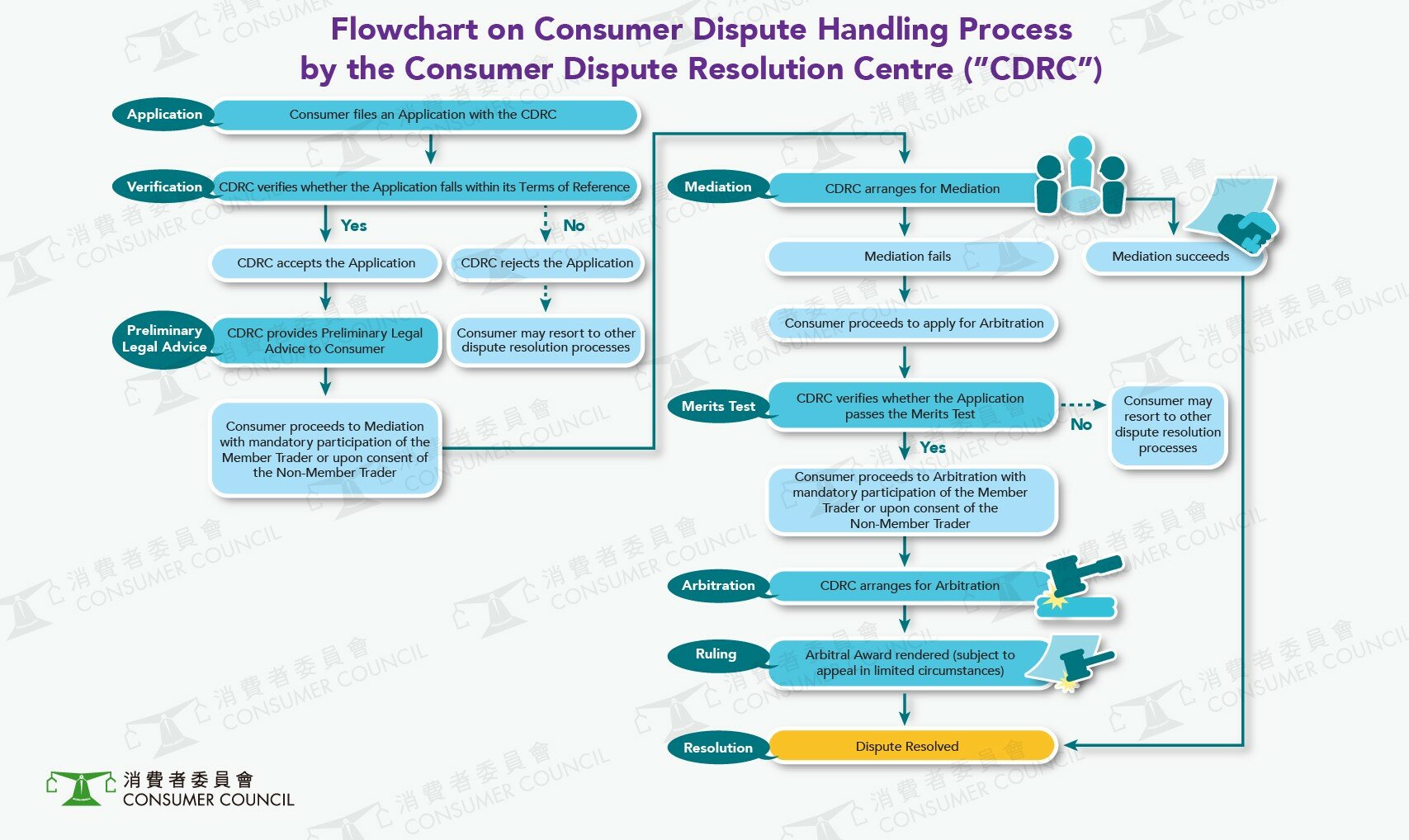The study by the Consumer Council shows that there is a remarkable potential demand for resolving consumer disputes by arbitration. In view of the fact that mediation and arbitration in Hong Kong are well-developed, the Council suggests introducing a cost-effective alternative dispute mechanism with the establishment of a Consumer Dispute Resolution Centre (CDRC) that funded by the Government to ensure the principles of fairness and justice are observed in managing every case for dispute resolution.
The Council proposes that the CDRC would provide preliminary legal advice to consumers and adopt the approach of "Mediation First, Arbitration Next" to offer consumers and traders a mechanism for resolving consumer disputes in a manner more efficient and cost-effective than litigation, while rendering legally binding agreement or decision. Another benefit of the new mechanism is to support relieving the caseload of the court, serve the interests of justice and foster a "Triple Win Situation" for consumers, traders and the Government.
Under the legal framework in Hong Kong, consumers and traders may through consensual process resolve their disputes. Such process includes negotiation between the parties directly and through a third party such as the Council. In the past 3 years, the Council received about 30,000 complaints annually arising from consumer transactions under different categories. Over 70% of the complaints were resolved by conciliation. Consumers of the unresolved cases would be left little choice, either merely give up their claims or make recourse to legal proceedings for resolving disputes.
Currently, the jurisdiction limit of the Small Claims Tribunal is $50,000. According to statistics of 2015, the average waiting time for the first hearing is 1 month, which would be followed by trial with a ruling several months later. Apart from the application fee of $20 to $120, consumers bear no cost for legal service as legal representation is not allowed. On the other hand, a claim over $50,000 would be dealt with by the District Court. It is difficult to estimate the legal cost to be incurred in the proceedings by consumer, which may include the legal cost of the trader in case a consumer loses the case.
If a consumer dispute has to be resolved through litigation, both the consumer and the trader have to face the lengthy process and the high cost of litigation. Even consumers who benefit from legal assistance or are willing to bear the legal costs, they still have to tackle the complicated legal procedure and pressure involved. Furthermore, the disclosure of case information may put the trader’s reputation and customer relationship at risk. Lawsuits resolving consumer disputes may also dilute the resources of judiciary for other cases. As a result, they would incessantly increase the total social costs in dealing with court litigation.
In devising the model for alternative dispute resolution, the Council has drawn reference from overseas experience. Currently, there are two main types, schemes funded by the Government and by the industry. For examples, in the United Kingdom and Australia, under the user-pay principle, there are schemes with statutory backup funded and operated by the industry. However, the experience in Canada shows that industry-funded model could affect fairness and impartiality as exemplified by the problem of repeat player effect as a result of frequent appointment of the same batch of arbitrators who tend to side with the trader. The experience of Portugal shows that scheme supported by the Government may ensure fairness, justice and independence. The Council believes that although a government-funded model would incur public resources, an impartial mechanism would give confidence to consumers and traders and reduce the litigation costs to society as a whole in the long term. Therefore, such a model is well deserved to be supported by stakeholders including the Government.
The Council considers that Hong Kong has a sound legal framework with adequate supply of highly competent professionals. Government policies in recent years also strongly support mediation and arbitration, forming favourable conditions for extending the use of arbitration from resolving commercial disputes to general consumer disputes. The Council presents the following 9 recommendations.
1. “Mediation First, Arbitration Next” Approach
CDRC shall attempt to resolve consumer disputes by mediation before engaging in arbitration, so that parties could better assess the merits of their own cases and carefully consider whether they should come to settlement or proceed to arbitration. Even if mediation fails, it could streamline the process of arbitration.
2. Government as Funding Source
The Council recommends the Government to fund the initial set up and recurrent operation expenses of the CDRC. Without infringing the principle of independence and fairness, this funding model is to be reviewed after 5 years of operation to include funding from the industry so as to lower the burden of public fund.
3. Free services for consumers
Consumers should enjoy free services from the CDRC, including the provision of preliminary legal advice before mediation, mediation services, and subject to merits test, arbitration service and legal representation during arbitration.
4. Traders’ participation
Traders’ who joined CDRC must deal with consumer disputes on the request of consumers in accordance with the ADR procedures provided by CDRC. Only participating traders can display a logo indicating that independent, impartial and affordable ADR procedures provided by the CDRC is readily available to consumers should they have any dispute with them. This could enhance consumer confidence to the participating traders.
5. Ensuring impartiality, independence and transparency
To ensure impartiality and independence, the Council recommends the responsible mediators and arbitrators shall disclose any actual or potential conflict of interests, and be appointed upon parties’ mutual agreement. Also, the CDRC should be governed by a well-balanced Board appointed by the Government. In addition, the CDRC should accept no sponsorship and it should provide full and accurate information on the progress of cases and how it could assist to resolve consumer disputes etc.
6. Maximum claimable amount is $200,000
Although more people could be benefited from a higher monetary claimable limit, it will also increase the burden on public fund. Having balanced the competing interests among consumers, traders and the society, the Council considers a cap of $200,000 could not only cover in general most of the consumer complaints received by the Council, but also claims which fall outside the jurisdiction of the Small Claim Tribunal ($50,000), and thereby reducing the case load of the District Court. Currently, 97% of the consumer disputes handled by the Council are below $50,000, introducing the ADR procedures provided by the CDRC would help reduce the pressure of the courts in handling consumer disputes.
7. Simplified procedures to save cost
The Council considers that arbitration procedures should be as simple and cost effective as possible, and the recoverable legal costs should also be limited so as to reduce overall cost of arbitration. Cost saving measures should also be employed without compromising the principle of fairness, such as “document only” arbitration for simple cases; “guillotine” or “chess clock” procedures to fix a reasonable and realistic time for oral hearing; imposing time limits for oral submissions etc.
Further, CDRC should bear the costs of appeal for consumers but it would be subject to another merits test if the appeal is to be lodged by consumers as the losing party.
8. Referral mechanism
A proper referral mechanism should be in place for the Council and the Judiciary to refer suitable consumer disputes to the CDRC. With such collaboration, the goal is to reduce the case load of Small Claims Tribunal and District Court, and enhance better allocation of resources to other adversarial cases.
9. Merger of the existing consumer dispute resolution schemes
At present, there are industry specific consumer dispute resolution schemes in finance and insurance industries to resolve sector specific complaints. The Council recommends to study the feasibility of merging the existing dispute resolution schemes into CDRC, which may optimize cost effectiveness through resource sharing.
Chairman of the Legal Protection Committee of the Council, Mr Samuel Chan, Barrister said “By this in-depth study, the Council recommends the introduction of a brand new CDRC, operating under the “Mediation First, Arbitration Next” mechanism, as an effective platform to facilitate dialogue between consumers and traders in resolving their disputes, reducing the chance of going to court and lowering litigation burden on the society. The Council hopes that all stakeholders could support the proposal and actively participate in and discuss the way forward in strengthening the consumer dispute resolution channels and mechanism.”





